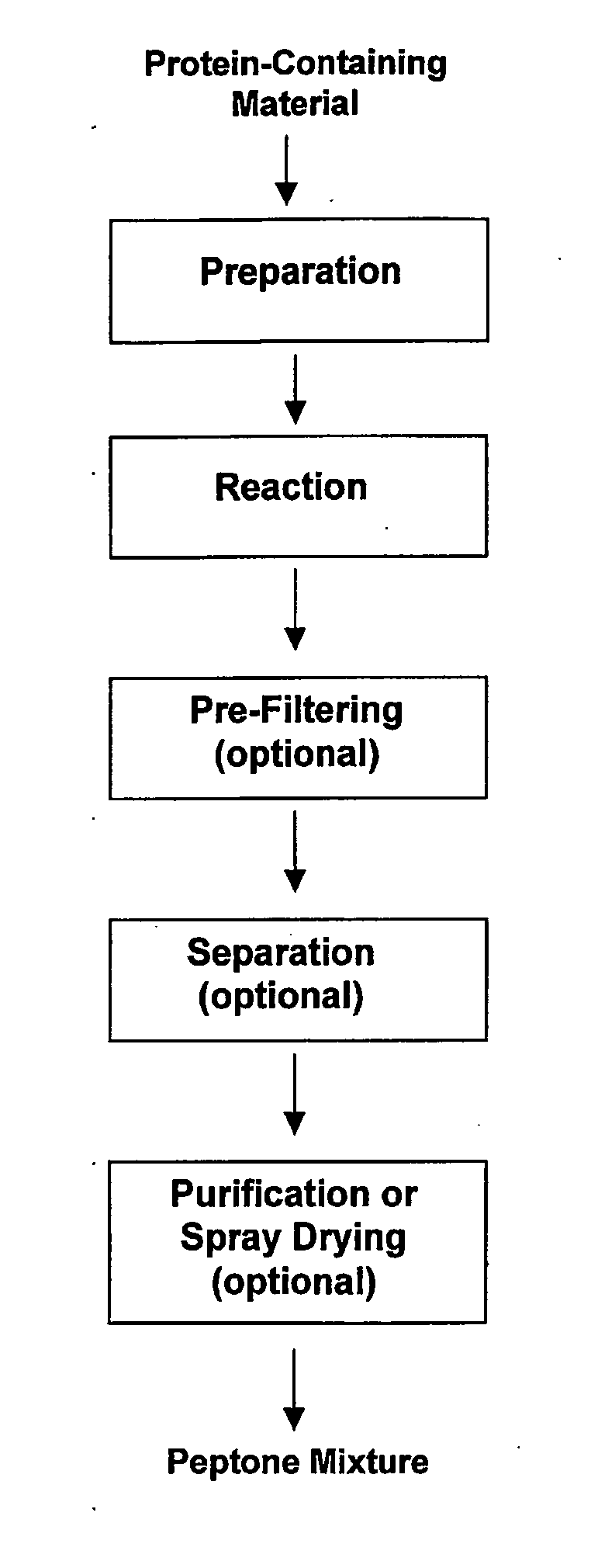Recovery of peptones
a peptone and recovery technology, applied in the field of peptone recovery, can solve the problems of inability to provide mixtures with sufficient solubility, desired molecular weight distribution or undamaged amino acid components, slow, inflexible, etc., and achieve the effect of high yield and rapid hydrolysis step
- Summary
- Abstract
- Description
- Claims
- Application Information
AI Technical Summary
Benefits of technology
Problems solved by technology
Method used
Image
Examples
example 0
l)
[0051] Five pounds of turkey feathers were provided from a plant in California, Mo. for testing. Three batches of feathers, weighing about 10 grams per batch, were analyzed to determine the total amino acid content of the feathers using an Beckman Amino Acid Analyzer. The analysis indicated the batches respectively contained 947,668.8 ppm amino acid content, 999,286.8 ppm amino acid content, and 863,446.2 ppm amino acid content. The amino acid content average for the three batches was 936,800.6 ppm amino acid or equivalently 93.68 wgt % of the feather material (on average) was made up of amino acids.
The results of example 0 are summarized in Tables 1A & 1B.
example 1
[0052] A quantity of feathers as received from the plant in California, Mo. was washed to remove dirt and other foreign matter. The washed feathers were dried. After washing and drying, a portion of the smaller feathers were ground into smaller pieces having an average maximum dimension of approximately 25 mm. The grinding was performed with standard chopping equipment. (Larger quills were excluded from the grinding because they did not grind well with the particular equipment used.) The resultant quantity of ground feathers weighed 10.99 grams.
[0053] The ground feathers were placed into a pressurized Parr reactor. The Parr reactor comprises a closed 1000 ml stainless steel vessel having a stainless steel mixer. The reactor has a digital control panel that displays and controls the temperature inside the reactor and the speed of the mixer. Reaction time, temperature, and pressure were monitored during the experiment. A digestion solution, 450 ml of 0.5 wgt % aqueous solution of sod...
example 2
[0058] Example 2 was conducted in essentially the same manner as example 1. The weight of the ground feathers was 44 grams. The digestion solution was 450 ml of 0.5 wgt % aqueous solution of sodium hydroxide. The pH of the digestion reaction medium was 13 to 14. The temperature for the hydrolysis digestion reaction was about 70 deg C., the digestion time was 1 hours, and the pressure for the digestion reaction was 0-10 psig. Visual inspection at the end of the digestion reaction showed complete digestion. Other test parameters were essentially the same as those described for example 1.
[0059] The final peptone material was white in color. In addition, the peptones had a similar appearance and flowability to those of example 1. Finally, the final peptone material contained 133,825.90 ppm of peptones based on the total starting material. The starting material contained (on average) 936,800.6 ppm amino acid content; hence the yield of small peptones was (133,825.90) / (936,800.6) or 14.3...
PUM
| Property | Measurement | Unit |
|---|---|---|
| temperature | aaaaa | aaaaa |
| molecular weight | aaaaa | aaaaa |
| pore size | aaaaa | aaaaa |
Abstract
Description
Claims
Application Information
 Login to View More
Login to View More - R&D
- Intellectual Property
- Life Sciences
- Materials
- Tech Scout
- Unparalleled Data Quality
- Higher Quality Content
- 60% Fewer Hallucinations
Browse by: Latest US Patents, China's latest patents, Technical Efficacy Thesaurus, Application Domain, Technology Topic, Popular Technical Reports.
© 2025 PatSnap. All rights reserved.Legal|Privacy policy|Modern Slavery Act Transparency Statement|Sitemap|About US| Contact US: help@patsnap.com


